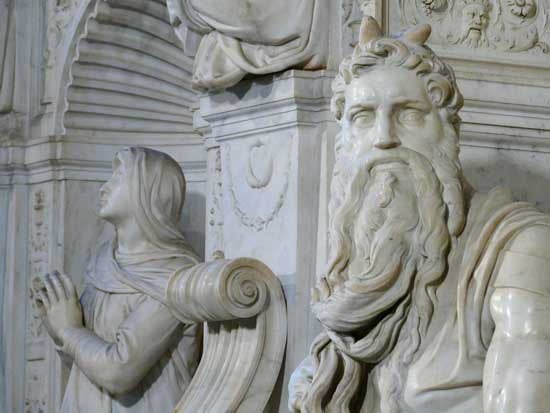I am sometimes asked, why prefer one translation of the Bible over another? My answer is that not all translations are created equal, and anyway, every translation is already an interpretation. And some older translations have all kinds of mistakes in rendering the Hebrew or the Greek. Here’s a classic example from the Latin Vulgate.
Perhaps you’ve gone to Rome and visited the church known as St. Peter in Chains, which has a famous marble statue of Michelangelo of Moses, based on the story in Exodus 34. Just one problem— the statue has horns, when it should have a veil over Moses’ face. Why???
Exod. 34.33 in Latin reads “videntes autem Aaron et filii Israhel cornutam Mosi faciem timuerunt prope accedere”. The key word here is ‘cornutam’ which is Latin for ‘horned’, when in fact the Hebrew tells us Moses was ‘veiled’ not horned as does the Greek. But because Latin was the official language of the Roman Catholic Church, and the Latin Vulgate (largely a translation by Jerome) was the official language of the Bible, Moses was thought to have horns, by Michelangelo and others. The end result of this is that Michelangelo, under commission from the Pope, produced the masterpiece seen above. Paul in 2 Cor. 3 is probably following the LXX of Exod. 34 at this point which clearly has ‘kalumma’—veil coverung Moses’ shining face, and the Hebrew text also has ‘veil’. It was not until Lorenzo Valla came along and pointed out the many errors of translation in the Vulgate, that this problem began to be corrected, and led to the better translations of Erasmus and others based not on the Latin Vulgate but on the more original Greek and Hebrew.
But actually the problem arose because of the Latin translation of the word for ‘shining’ found in multiple places in this text in Exod. 34. G.W Eggins points out that the Hebrew word for ‘shining is qaran which is similar to the Hebrew for horned, qeren. The problem came about because the original Hebrew text which Jerome had was unpointed, by which I mean without vowels and simply read QRN, which could be read either way. From the 12th to the 15th century Moses was regularly depicted with horns, until Protestants in the 15th century and later pointed out this hilarious mistake.[1]
[1] https://www.theguardian.com/notesandqueries/query/0,5753,-1493,00.html














